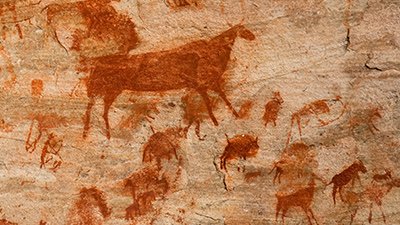
New Findings Show That Cavemen Valued Singing
LiveScience: “Cave Men Loved to Sing” Those oft-portrayed cave-painting “cavemen” were more than mere artists: they were concertmasters skilled in mixing visual art with sound, reports LiveScience.
Research conducted by Iegor Reznikoff, a specialist in ancient music at the University of Paris X, has uncovered a strange connection between ancient cave paintings and musical acoustics: the most densely painted areas of several French caves are also those with the best acoustics.
The most densely painted areas of several French caves are also those with the best acoustics.
Reznikoff’s conclusion is that those responsible for the paintings had “fine-tuned” hearing that allowed them to recognize the acoustics of various parts of those caves. Thus, they painted in those locations as they sang or hummed—where the music sounded best. LiveScience reports:
A trained vocalist was sent through the caves testing different sounds and pitches in various locations. Spots of maximum resonance, or places where the voice was most amplified and clear, were noted in each section and later laid over a map of the cave drawings. The vast majority of the paintings, up to 90 percent in some cases, were located directly at, or very near, the spots where the acoustics were the absolute best, they found.
Additionally, Reznikoff ties his hypothesis in with cave exploration. When exploring caves with only torches—which couldn’t fit into small passages—ancient hunters could have used their voices like sonar to determine the layout and size of the caves they were in. LiveScience also includes this impressive finding:
Single red spots were even discovered in the most resonant areas of tiny tunnels where people could only have crawled in the dark, suggesting that the paintings were not just coincidentally located in the biggest, best open spaces where the sound was also rich[.]
Additionally, such outdoor venues as the Altar Stone at Lac de Merveilles in France—which is covered with more than a thousand pictures—are considered prime acoustic environments.
The classic view of cavemen and other “ancient” humans is that they were brutish, preliterate dolts who had not even a fraction of the culture, sophistication, or intelligence of today’s humans. But research like Reznikoff’s reminds us that our human forebears were incredibly intelligent, skilled in ways most modern humans lack, and—most importantly—created in the image of God.
For more information:
Remember, if you see a news story that might merit some attention, let us know about it! (Note: if the story originates from the Associated Press, Fox News, MSNBC, the New York Times, or another major national media outlet, we will most likely have already heard about it.) And thanks to all of our readers who have submitted great news tips to us.
(Please note that links will take you directly to the source. Answers in Genesis is not responsible for content on the websites to which we refer. For more information, please see our Privacy Policy.)
Recommended Resources

Answers in Genesis is an apologetics ministry, dedicated to helping Christians defend their faith and proclaim the good news of Jesus Christ.
- Customer Service 800.778.3390
- Available Monday–Friday | 9 AM–5 PM ET
- © 2025 Answers in Genesis



